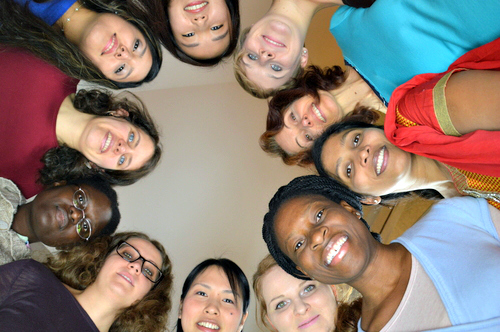
One White Woman’s Thoughts on Being Multi-Cultural
“Before you go and live in Guatemala to study Spanish, you need to read this book,” my friend advised. Easily detecting my time-is-of-the-essence-say-it-like-it-is-I-can-do-this-on-my-own base culture, she knew I needed a multi-cultural “crash course” before my extended stay in Guatemala. As she is a second-generation missionary having served more than fifty years in Latin America, I heeded her advice, and I’m glad I did. Unknown cultural blinders fell from my eyes when I read her recommendation, From Foreign to Familiar: A Guide to Understanding Hot- and Cold-Climate Cultures.
The multi-cultural information gleaned from this book not only made me aware of what I had been doing wrong while serving in U.S. Hispanic Ministry, but also shed light on the cause of many marital miscommunications between my Mexican husband and me. Additionally, I give this book credit for preventing a divisive misunderstanding between our Canadian and Cuban cohorts during a short-term mission trip. Needless to say, I’ve been recommending this book to many others ever since.
What have I learned? How did cultural blinders fall from my eyes? This book (and others like it) made me realize there is a vast divide between the values of Individualistic Cultures and Relational Cultures.

(Graphic by Tripylon Media.)
As indicidated by the regions in yellow, the Individualistic Cultures are:
- USA
- Canada
- Western Europe
- Australia
As indicated by the regions in red, the Relational Cultures are:
- Mexico
- Caribbean
- Central America
- South America
- Southern Europe (e.g. Spain, Italy)
- Africa
- Asia
(Note, that these regions with Relational Cultures make up the majority of the world.)
The following infographic from the ministry, HonorShame, explains well the value differences between these two cultures and consequently, how people from these distinct cultural types view each other.*

Is the above information eye-opening to you? It was to me. In my time-is-of-the-essence-say-it-like-it-is-I-can-do-this-on-my-own base culture, what had I been communicating to my husband and our U.S. Hispanic congregation?
- Time is of the essence = Your tasks are more important than relationships.
- Say it like it is = Your honesty comes across as rude and impolite and you do not value the harmony of relationships.
- I can do this on my own = You value yourself above the family or the congregation.
Ouch. I’d had no idea that my modus operandi was speaking volumes, and offensive volumes at that.
Why do I share this with you? I share this because your company, church, or ministry is becoming increasingly diverse, regardless of the country in which you reside.
What are you communicating without saying a word? Is your Christian witness reaching across the cubicle at work and communicating grace and acceptance in your coworker’s cultural language? Or like me, have you been unknowingly communicating individualism, disrespect, and arrogance?
My multi-cultural learning curve, at times, has seemed steep, but not impossible. Consider how the Apostle Paul adapted himself during his highly effective years of multi-cultural ministry:
Even though I am a free man with no master, I have become a slave to all people to bring many to Christ. When I was with the Jews, I lived like a Jew to bring the Jews to Christ. When I was with those who follow the Jewish law, I too lived under that law. Even though I am not subject to the law, I did this so I could bring to Christ those who are under the law. When I am with the Gentiles who do not follow the Jewish law,I too live apart from that law so I can bring them to Christ. But I do not ignore the law of God; I obey the law of Christ.
When I am with those who are weak, I share their weakness, for I want to bring the weak to Christ. Yes, I try to find common ground with everyone, doing everything I can to save some. I do everything to spread the Good News and share in its blessings. (1 Cor. 9:19-23 NLT)
Depending to whom he was trying to minister, the Apostle Paul adapted himself accordingly. He did not expect others to adapt to his culture. Regardless of the dominant versus minority culture, he did whatever he had to do to win others for Christ.
Challenge: What does walking in the footsteps of Paul look like for you? How are you trying to “become all things to all people so that by all possible means [you] might save some”? (1 Cor. 9:22 NIV)
For me, it means I continually have one foot in my Individualistic Culture and one foot in our congregation’s Relational Culture. I have to evaluate, many times by activity, how to act, respond, and even when to show up to a party. For my Mexican husband, he has to operate between cultures as well. Cultural adaptation is not just one-sided. We both operate in discomfort daily. But our end goal, to win others for Christ, keeps us plodding along despite the discomfort.
Personal Reflection: Is your goal to be comfortable? Or is your goal to minister where God has planted you? Ask yourself, “Who is my neighbor, my office-mate, my grocery store cashier, or my landscaping contractor? How can I communicate the love of Christ in their cultural language?”
This blog article was originally posted on October 9, 2017.
*There are exceptions. My Mexican husband tells me the culture of Mexico City is much more like that of New York City (Individualistic) than the rest of Mexico (Relational). Puerto Rico, a U.S. Territory, is much more like Central and South America (Relational) than mainland USA (Individualistic). But generally, the above cultural distinctions hold true.




